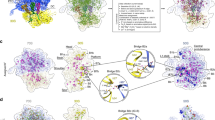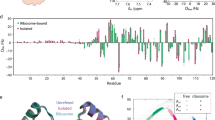Abstract
MACROMOLECULAR single-stranded RNA from viruses and ribosomes is now generally thought to contain short double-helical regions1 formed when the polynucleotide chain bends back on itself. The existence of such regions was largely inferred from the changes in ultra-violet absorption which occurred on heating solutions of macromolecular RNA. What, however, is the relation between the configuration of macromolecular ribosomal RNA in solution and in the original ribosome? Yeast ribosomes have been reported to have an optical density equal to the sum of the optical densities of the separated RNA and protein2. Other evidence has been obtained by measuring the changes in ultra-violet absorption of ribosomes when these are heated (and from X-ray diffraction investigations3). The increases in ultra-violet absorption which were observed were the same4 or about two-thirds1a of those of the isolated ribosomal RNA. Measurement of increases in ultra-violet absorption on heating mixed systems of nucleic acids and proteins is not always very satisfactory on account of turbidity changes (for example, ref. 5) and independent evidence has therefore been sought by measuring the optical rotatory dispersion curves of intact ribosomes and of the RNA and protein isolated from them.
This is a preview of subscription content, access via your institution
Access options
Subscribe to this journal
Receive 51 print issues and online access
$199.00 per year
only $3.90 per issue
Buy this article
- Purchase on Springer Link
- Instant access to full article PDF
Prices may be subject to local taxes which are calculated during checkout
Similar content being viewed by others
References
(a) Hall, B. D., and Doty, P., J. Mol. Biol., 1, 11 (1959). (b) Doty, P., Boedtker, H., Fresco, J. R., Haselkorn, R., and Litt, M., Proc. U.S. Nat. Acad. Sci., 45, 482 (1959). (c) Doty, P., Biochem. Soc. Symp., No. 21, 8 (1962). (d) Fresco, J. R., Alberts, B. M., and Doty, P., Nature, 188, 98 (1960).
Bonhoeffer, F., and Schachman, H. K., Biochim. Biophys. Res. Comm., 2, 366 (1960).
Zubay, G., and Wilkins, M. H. F., J. Mol. Biol., 2, 105 (1960). Klug, A., Holmes, K. C., and Finch, J. T., J. Mol. Biol., 3, 87 (1961).
Schlessinger, D., J. Mol. Biol., 2, 92 (1960).
Lee, M. F., Walker, I. O., and Peacocke, A. R., Biochem. Biophys. Acta, 72, 310 (1963).
Cox, R. A., and Arnstein, H., Biochem. J., 89, 574 (1963).
Samejima, T., and Yang, J. T., Biochemistry, 3, 613 (1963).
Haydon, A. J., and Peacocke, A. R. (unpublished observations).
Samejima, T., and Yang, J. T., J. Biol. Chem., 240, 2094 (1965).
Author information
Authors and Affiliations
Rights and permissions
About this article
Cite this article
BLAKE, A., PEACOCKE, A. Optical Rotatory Dispersion and Secondary Structure of Ribonucleic Acid in Mammalian Ribosomes. Nature 208, 1319–1320 (1965). https://doi.org/10.1038/2081319a0
Published:
Issue Date:
DOI: https://doi.org/10.1038/2081319a0
This article is cited by
-
Internal Organization of the Ribosome
Nature (1967)
Comments
By submitting a comment you agree to abide by our Terms and Community Guidelines. If you find something abusive or that does not comply with our terms or guidelines please flag it as inappropriate.



